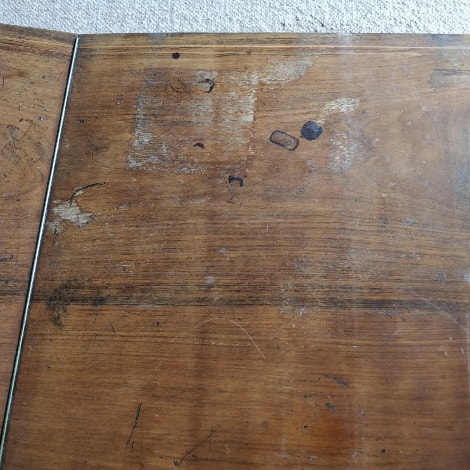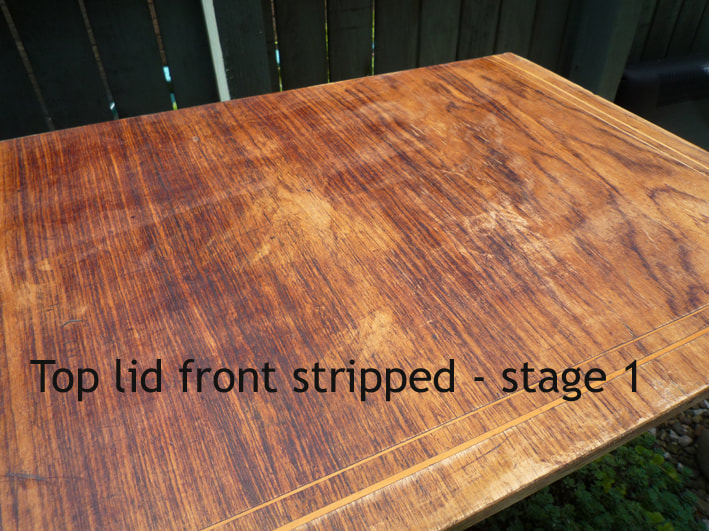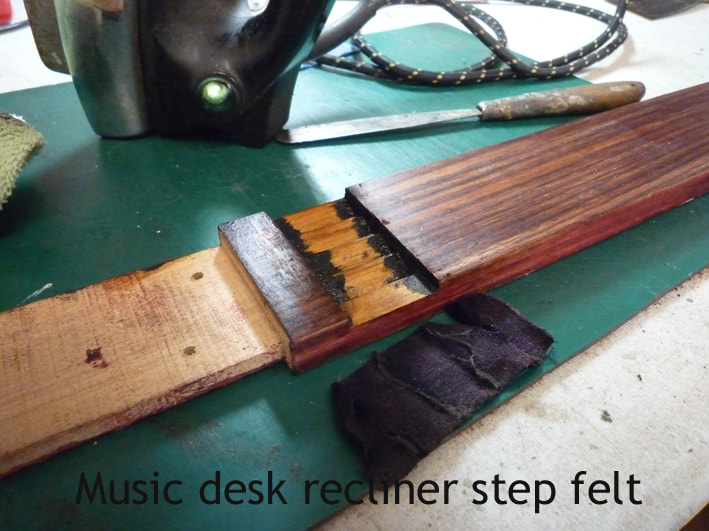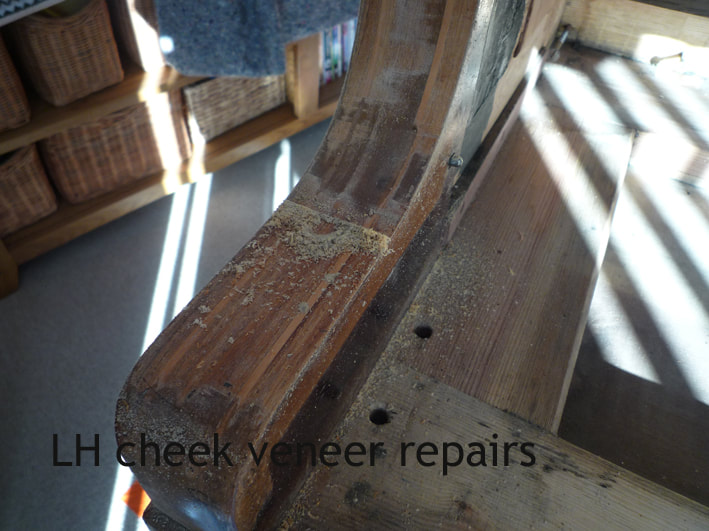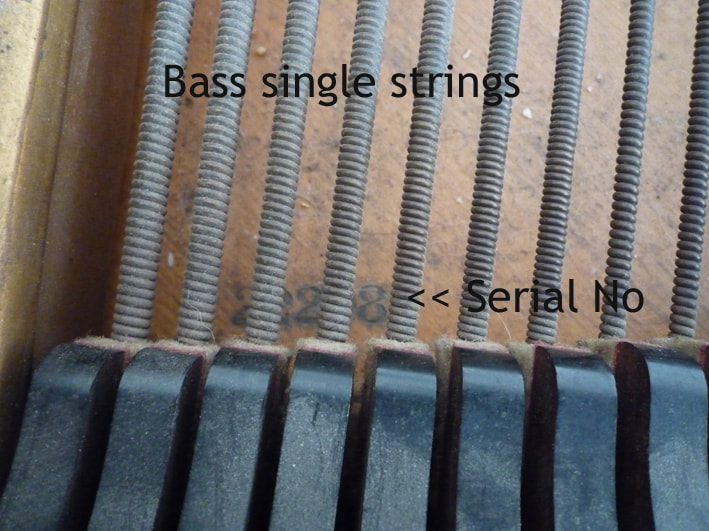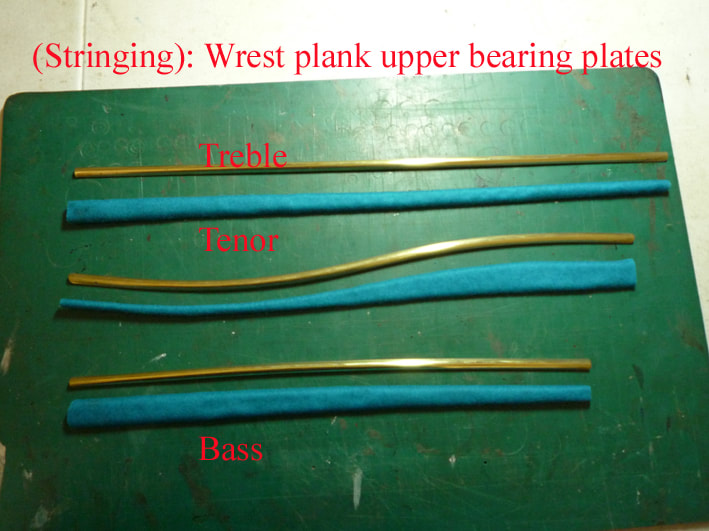** for sale ** only £3,995*
max adolph - berlin - boudoir baby grand piano
restoration portfolio 2020 - 2021
CONTACT ME
I was out for a routine "tuning" to a new customer, who was a retired musician. A bass string had previously broken (not me!), and the top lid was on the sofa !! .... ready to crash to the floor. Some of the dampers were also seized "on" - so tuning would have been difficult. The piano was located in Longhoughton, near Alnwick, Northumberland.
This restoration blog shows most of the details about the work.
*This piano is currently advertised at a reduced rate, for a limited period only.
See a video of the fully restored piano (Chopin Nocturne) >> CLICK HERE
BEFORE RESTORATION
I was out for a routine "tuning" to a new customer, who was a retired musician. A bass string had previously broken (not me!), and the top lid was on the sofa !! .... ready to crash to the floor. Some of the dampers were also seized "on" - so tuning would have been difficult. The piano was located in Longhoughton, near Alnwick, Northumberland.
This restoration blog shows most of the details about the work.
*This piano is currently advertised at a reduced rate, for a limited period only.
See a video of the fully restored piano (Chopin Nocturne) >> CLICK HERE
BEFORE RESTORATION

The piano is dated 1928 (the year punched into one side of the fallboard), and having the serial number #22298.
I believe the serial number is a combination of the year, which I will investigate, hence 22298
It was common for some piano makers to incorporate the year's first and last digits into the serial number. More to follow.
The cabinet (casework) is veneered oak with box wood inlaid double-banding throughout. Some smaller parts (e.g. top lid prop stick cup) is made from solid mahogany and stained to match.
The following image showing the attractive double-banding, contoured around the RH cheek (before restoration).
The piano has dual-gate legs, two castors per "leg". This also blends in with an unusual "H" beam (like a cross bar), joining the front legs at each end to the pedal lyre, adding more interest to the cabinet, and also adding more stability to the pedal lyre.

The beam is secured with a large wooden dowel that pushes into the side of each lyre pillar, and at the gate leg end, secured with a "Y" joint and screw.
Unfortunately the wooden lyre stay rod (behind) is missing, so this will be ordered soon. Although difficult to see, each side of both pillars bears the double-banding wood inlay.
The pedal lift rods (behind) are made from tubular brass rods, encased in hard wood. All the pedal workings are in original condition, but need extensive restoration. The lyre stay rod was missing.
PIANO SPECIFICATIONS
MAX ADOLPH BERLIN
Boudoir German Baby Grand Piano
Serial Number: #22298
Year of Manufacture: 1928
Oak veneer with box wood double-banding
Oak & Mahogany Music Desk Tray with Mother of Pearl droplets and wood & brass inlay crowns
Dual Gate legs with lyre beam / 2 pedals
DIMENSIONS:
Length: 4ft 7 inches / 140 cm
Width: 4ft 4 inches / 132 cm
Height: 3ft 3 inches / 99 cm
Over-damped / over-strung (new)
Full cast iron frame gilded in a deep "German Bronze"
Weight: approx. 0.25 TONS
Mechanism: Roller action with triple-sprung lever action
Keyboard: 7 octaves / 85 notes
Piano stool: YES, included, - matching, with wicker detail/ box hinge for music books
Photos: c.300+ images in full colour available 10cm X 15cm by USB for those not shown here.
Images may be seen either during an appointment and after purchase - hand delivered to new client.
Delivery can be arranged at extra cost.
Brief description of work:
Full restoration to: Cabinet / pedals / new strings & tuning pins / Dampers / Gilt frame work.
Full refurbishment to mechanism Hammers: extensive cleaning / reface hammer heads / re-pinned / toning
Lever undercarriages & jacks: Full refurbishment / re-pinned / new loops X 255 (jacks, levers & rep levers) / new springs
Dampers: Complete restoration to damper lever system & head felts / re-bushed guide rail bushings
The whole mechanism has been re-pinned with top quality chromium plated steel centre pins.
The piano has been fully re-strung and re-scaled with new Roslau German piano wire. New bass strings made to pattern, with double eyes for the hitch pins. Piano rim decorated in Royal Blue twisted silk cord.
Restoration to keyboard: Ivories replaced for new key tops / new bushings/ key frame parts refurbished
Piano stool: Refurbished "wicker" period stool / re-upholstered.
Stringing & frame: Brand new bass & treble strings / new tuning pins / cast iron frame re-gilded / new plates
Cabinet: Completely stripped / repairs / finished in bees wax. Legs & pedal lyre restoration
More "before" photos >>
MAX ADOLPH BERLIN
Boudoir German Baby Grand Piano
Serial Number: #22298
Year of Manufacture: 1928
Oak veneer with box wood double-banding
Oak & Mahogany Music Desk Tray with Mother of Pearl droplets and wood & brass inlay crowns
Dual Gate legs with lyre beam / 2 pedals
DIMENSIONS:
Length: 4ft 7 inches / 140 cm
Width: 4ft 4 inches / 132 cm
Height: 3ft 3 inches / 99 cm
Over-damped / over-strung (new)
Full cast iron frame gilded in a deep "German Bronze"
Weight: approx. 0.25 TONS
Mechanism: Roller action with triple-sprung lever action
Keyboard: 7 octaves / 85 notes
Piano stool: YES, included, - matching, with wicker detail/ box hinge for music books
Photos: c.300+ images in full colour available 10cm X 15cm by USB for those not shown here.
Images may be seen either during an appointment and after purchase - hand delivered to new client.
Delivery can be arranged at extra cost.
Brief description of work:
Full restoration to: Cabinet / pedals / new strings & tuning pins / Dampers / Gilt frame work.
Full refurbishment to mechanism Hammers: extensive cleaning / reface hammer heads / re-pinned / toning
Lever undercarriages & jacks: Full refurbishment / re-pinned / new loops X 255 (jacks, levers & rep levers) / new springs
Dampers: Complete restoration to damper lever system & head felts / re-bushed guide rail bushings
The whole mechanism has been re-pinned with top quality chromium plated steel centre pins.
The piano has been fully re-strung and re-scaled with new Roslau German piano wire. New bass strings made to pattern, with double eyes for the hitch pins. Piano rim decorated in Royal Blue twisted silk cord.
Restoration to keyboard: Ivories replaced for new key tops / new bushings/ key frame parts refurbished
Piano stool: Refurbished "wicker" period stool / re-upholstered.
Stringing & frame: Brand new bass & treble strings / new tuning pins / cast iron frame re-gilded / new plates
Cabinet: Completely stripped / repairs / finished in bees wax. Legs & pedal lyre restoration
More "before" photos >>
001 PEDAL LYRE & PARTS
Full restoration to lyre veneer, pedal box, trap mechanism, brass pedals, lift rods, and a new lyre stay rod fitted.
Full restoration to lyre veneer, pedal box, trap mechanism, brass pedals, lift rods, and a new lyre stay rod fitted.
002 CABINET
A selection of images showing some of the main cabinet parts during strip down, scraping, sanding & veneer repairs.
Chemically stripped and hand-scraped/ sanded, the cabinet has been sensitively restored, regaining its character & patina.
All wood parts have been treated with several layers of natural bees wax.
A selection of images showing some of the main cabinet parts during strip down, scraping, sanding & veneer repairs.
Chemically stripped and hand-scraped/ sanded, the cabinet has been sensitively restored, regaining its character & patina.
All wood parts have been treated with several layers of natural bees wax.
003 STRINGING & DAMPERS (before)
004 CAST IRON FRAME RESTORATION
The frame went under extensive cosmetic repairs over a 3 day process.
1. Original gilding was badly chipped & marked - sanded down & chemical cleaning
2. Masking to whole piano (cabinet, soundboard, bridges, hitch pins, felt areas etc) - only revealing the iron frame
3. Beige/ grey primer - 3 coats (sanded between coats)
4. Re-gilded in period gold-bronze acrylic spray lacquer - 4 coats
5. Clear lacquer (gloss) - 3 coats
6. Masking removed
7. Wrest plank (tuning pin areas): New "Bechstein Blue" felt to wooden plates & brass bearing strips polished
The frame went under extensive cosmetic repairs over a 3 day process.
1. Original gilding was badly chipped & marked - sanded down & chemical cleaning
2. Masking to whole piano (cabinet, soundboard, bridges, hitch pins, felt areas etc) - only revealing the iron frame
3. Beige/ grey primer - 3 coats (sanded between coats)
4. Re-gilded in period gold-bronze acrylic spray lacquer - 4 coats
5. Clear lacquer (gloss) - 3 coats
6. Masking removed
7. Wrest plank (tuning pin areas): New "Bechstein Blue" felt to wooden plates & brass bearing strips polished
005 RESTRINGING
Due to previously broken strings, and the lack of tonal quality, this piano has undergone a complete restring.
The whole structure of the soundboard & bridges have been checked, and are in good condition with no cracks or separations.
The wrest plank is also in excellent condition.
Using the finest quality graded piano wire, the treble has been restrung with high tensile steel Roslau German wire, and
the bass has been restrung with all 46 pattern (bespoke) bass strings (singles & bi-chords).
The middle section of the stringing has been upgraded with various half-gauge wires to assist in gradual tensioning of the wire,
to ensure better stability than originally in 1928. .
The piano now boasts a wonderful tone throughout, deep bass, and reflects on the new cast iron work, just as it did
when it left the factory in 1928. See video
The new tuning pins are slightly oversized (7.00mm), with tremendous torque to ensure good tuning stability for another 100 years +
The piano is now fully up to tension (about 18 tons of force), and has been tuned several times so far.
A dream of a piano for any piano tuner to tune, with all tuning pins at a consistent torque.
The new owner should realise that the stringing process and final tuning takes around 12-18 months to fully settle down, as the strings
are re-stretched & tensioned several times. The piano is also at Concert Pitch - C523.3Hz (Middle C) or A440 Hz.
For the first year, it is recommended to have the piano re-tuned 3-4 times a year.
Year 2: 2-3 times.
Year 3+ : Every 6 months (regularly played).
The piano must be kept away from any heated radiator, or sustained central heating.
Optimum temperature: 15 - 18 degrees Optimum Humidity: 55%
A digital thermometer & (combined) hygrometer should be purchased and simply rested on this piano to monitor its condition.
KEYBOARD / MISC. REPAIRS
Due to the original condition of the ivory head plates (the part of the key that is played), many were chipped, cracked, DIY replaced,and so it was not possible to save or restore the existing ivories. This is quite common on old pianos.
The white keys have all been replaced with high quality cream coverings to match the period of the instrument.
All 85 keys have been re-bushed as seen below >>
Due to previously broken strings, and the lack of tonal quality, this piano has undergone a complete restring.
The whole structure of the soundboard & bridges have been checked, and are in good condition with no cracks or separations.
The wrest plank is also in excellent condition.
Using the finest quality graded piano wire, the treble has been restrung with high tensile steel Roslau German wire, and
the bass has been restrung with all 46 pattern (bespoke) bass strings (singles & bi-chords).
The middle section of the stringing has been upgraded with various half-gauge wires to assist in gradual tensioning of the wire,
to ensure better stability than originally in 1928. .
The piano now boasts a wonderful tone throughout, deep bass, and reflects on the new cast iron work, just as it did
when it left the factory in 1928. See video
The new tuning pins are slightly oversized (7.00mm), with tremendous torque to ensure good tuning stability for another 100 years +
The piano is now fully up to tension (about 18 tons of force), and has been tuned several times so far.
A dream of a piano for any piano tuner to tune, with all tuning pins at a consistent torque.
The new owner should realise that the stringing process and final tuning takes around 12-18 months to fully settle down, as the strings
are re-stretched & tensioned several times. The piano is also at Concert Pitch - C523.3Hz (Middle C) or A440 Hz.
For the first year, it is recommended to have the piano re-tuned 3-4 times a year.
Year 2: 2-3 times.
Year 3+ : Every 6 months (regularly played).
The piano must be kept away from any heated radiator, or sustained central heating.
Optimum temperature: 15 - 18 degrees Optimum Humidity: 55%
A digital thermometer & (combined) hygrometer should be purchased and simply rested on this piano to monitor its condition.
KEYBOARD / MISC. REPAIRS
Due to the original condition of the ivory head plates (the part of the key that is played), many were chipped, cracked, DIY replaced,and so it was not possible to save or restore the existing ivories. This is quite common on old pianos.
The white keys have all been replaced with high quality cream coverings to match the period of the instrument.
All 85 keys have been re-bushed as seen below >>
006 MECHANISM
The main mechanism inside is the heart of the instrument, and has been fully refurbished / hundreds of parts replaced.
Consisting of the dampers, hammers, undercarriage levers, jacks and the keyboard. The dampers were covered above.
HAMMERS
The hammers provide the unique tone of the piano (along with the new strings)
Work includes pre-cleaning and a full strip down of all hammer components.
The main mechanism inside is the heart of the instrument, and has been fully refurbished / hundreds of parts replaced.
Consisting of the dampers, hammers, undercarriage levers, jacks and the keyboard. The dampers were covered above.
HAMMERS
The hammers provide the unique tone of the piano (along with the new strings)
Work includes pre-cleaning and a full strip down of all hammer components.

Diagram drawn by hand by Colin Nicholson. (click to enlarge)
Showing the main action parts of the Max Adolph mechanism.
All parts have been fully stripped down, re-pinned (even if not required), carefully assembled and regulated. The hammers have had a full service including a reface, re-pin, deep clean and several rollers replaced.
Showing the main action parts of the Max Adolph mechanism.
All parts have been fully stripped down, re-pinned (even if not required), carefully assembled and regulated. The hammers have had a full service including a reface, re-pin, deep clean and several rollers replaced.

Bass hammers being prepared for sanding, refacing, toning.
All 85 flanges (top) to be cleaned and drop screws freed off.
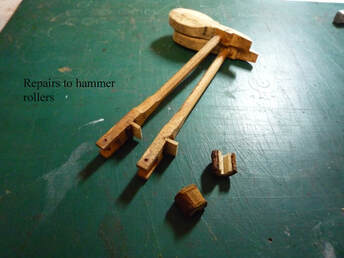
Hammer rollers X 2 replaced
UNDERCARRIAGE LEVERS
The levers consist of the main undercarriage, repetition lever and jack assembly, with various springs and loops.
The levers are located between the hammers & keys, and are responsible for rapid & fast repetition of notes, and to control the hammer movement.
These parts have been extensively restored with all 255 brand new loops (85 X 3), new flange springs / drop screw cloth & more.
There was about 175 hours of labour carried out on the levers alone.
A common repair job on an old grand piano is BROKEN LOOPS. If a jack loop breaks, the note stops working - simple as that.
A single loop replacement call-out would cost in the region of £45 plus travel/ 2 journeys, as the repair cannot be done in the customer's home (drilling out old parts), and the broken part(s) needs to be taken away. Average cost would be £60 per repair (separate to tuning).
That's fine for the odd one-off repair...... but imagine this......
Let's multiply that ...... £60 X 255 = £15, 300.00 (yes, over £15K!) .... so to take away the risk completely, ALL loops have been replaced, and the mechanism will play beautifully for another 100 years. This massive amount of work has been incorporated into the cost of the whole piano. .
The levers consist of the main undercarriage, repetition lever and jack assembly, with various springs and loops.
The levers are located between the hammers & keys, and are responsible for rapid & fast repetition of notes, and to control the hammer movement.
These parts have been extensively restored with all 255 brand new loops (85 X 3), new flange springs / drop screw cloth & more.
There was about 175 hours of labour carried out on the levers alone.
A common repair job on an old grand piano is BROKEN LOOPS. If a jack loop breaks, the note stops working - simple as that.
A single loop replacement call-out would cost in the region of £45 plus travel/ 2 journeys, as the repair cannot be done in the customer's home (drilling out old parts), and the broken part(s) needs to be taken away. Average cost would be £60 per repair (separate to tuning).
That's fine for the odd one-off repair...... but imagine this......
Let's multiply that ...... £60 X 255 = £15, 300.00 (yes, over £15K!) .... so to take away the risk completely, ALL loops have been replaced, and the mechanism will play beautifully for another 100 years. This massive amount of work has been incorporated into the cost of the whole piano. .

The loops for this single lever undercarriage are highlighted in blue - X Y Z
Each lever has its own set of 3 springs, attached to a loop to operate the lever correctly. Some other standard grand pianos do not have Y and Z loops (X loops & springs are common on Steinway), and standard grand pianos have only one spring Y and Z combined (like a wishbone spring) located inside the lever.
On the Max Adolph Berlin mechanism, there is a lot of extra work, that many other technicians would not carry out the work (yet claiming the piano has been restored).
Some of the following stages show the intricate work to replace every loop.

X LOOPS - LEVER FLANGE REAR
Here is one of the culprits.... a very worn and frail loop cord.
All original olive green cotton, press-fitted into each side of the flange. The apex of the loop is also squashed flat from the spring tail pulling on it over 92 years.
The spring and loop here help to balance the lever, to prevent it from collapsing under its own weight. Even though these loops had not broken, the springs were very weak, lacking any tension, and not worth the risk to just put back. Just a matter of time before they break.
Here is one of the culprits.... a very worn and frail loop cord.
All original olive green cotton, press-fitted into each side of the flange. The apex of the loop is also squashed flat from the spring tail pulling on it over 92 years.
The spring and loop here help to balance the lever, to prevent it from collapsing under its own weight. Even though these loops had not broken, the springs were very weak, lacking any tension, and not worth the risk to just put back. Just a matter of time before they break.

Y PART - JACK LOOPS
All loops are replaced with high quality black poly braid, which is equivalent to "Kevlar" cord and does not rot - used also for professional kites and a cord I use regularly in rocketry (assisting the recovery system) - which is also fire proof.
I have just recently built a replica of the Saturn V (100:1 scale) rocket, and used the same cord for this piano.
Image to the left showing some of the prep stages for removing the old jack loop cords.
To ensure the new loop is balanced evenly, all old jack loops & pegs are drilled out at a 17 degree angle to compensate for the sloping angle of the jack when located on the lever.
If this loop breaks (which it won't now), the note stops working. The jack flicks back at high speed to reset itself under the hammer roller, and each jack has its own leaf spring - and are VERY STRONG!
All loops are replaced with high quality black poly braid, which is equivalent to "Kevlar" cord and does not rot - used also for professional kites and a cord I use regularly in rocketry (assisting the recovery system) - which is also fire proof.
I have just recently built a replica of the Saturn V (100:1 scale) rocket, and used the same cord for this piano.
Image to the left showing some of the prep stages for removing the old jack loop cords.
To ensure the new loop is balanced evenly, all old jack loops & pegs are drilled out at a 17 degree angle to compensate for the sloping angle of the jack when located on the lever.
If this loop breaks (which it won't now), the note stops working. The jack flicks back at high speed to reset itself under the hammer roller, and each jack has its own leaf spring - and are VERY STRONG!

Z LOOPS - REPETITION LEVERS
As a test, I gently pulled on one of the old loops, and guess what? .... yes it broke apart in my hand. So all of these have been replaced with other components.
These levers live up to their name.... "repetition lever", and responsible for suspending the hammer to aid very fast repetition of the note (e.g. trills, scales). This lever and its function is not available on upright pianos - only grands.
These levers have an unusual "umbrella" spring that is guided over the top of the rep lever, and hooked onto the loop.
The loop cords and plugs are punched out using a 3mm punch, but some needed a bit more help. As the poly cord (and combined) thickness of the new pegs is about 3.5mm with a gentle glide, all rep lever holes were drilled out further.... X 85.
Some more images of the rep levers (and oh yeh, a quicky photo of my SAT V !)
As a test, I gently pulled on one of the old loops, and guess what? .... yes it broke apart in my hand. So all of these have been replaced with other components.
These levers live up to their name.... "repetition lever", and responsible for suspending the hammer to aid very fast repetition of the note (e.g. trills, scales). This lever and its function is not available on upright pianos - only grands.
These levers have an unusual "umbrella" spring that is guided over the top of the rep lever, and hooked onto the loop.
The loop cords and plugs are punched out using a 3mm punch, but some needed a bit more help. As the poly cord (and combined) thickness of the new pegs is about 3.5mm with a gentle glide, all rep lever holes were drilled out further.... X 85.
Some more images of the rep levers (and oh yeh, a quicky photo of my SAT V !)
BEFORE + AFTER
Before, the mechanism lacked any real response and accuracy. Many of the parts were sluggish/ saggy and the touch was uneven, having to play some of the keys much harder to produce any kind of volume required. With not having any previous service records for this piano, a full restoration took place. The lever parts were THICK with dust, debris and pet hairs, and only a few of the rep levers were liquid graphited......
After: The mechanism is now very responsive indeed, with lightning-speed repetition/ light touch (for any advanced pianists out there), and will cope with anything thrown at it from novice to concert / diploma standard. I have also balanced all the parts carefully (regulated), and all the springs have been re-tensioned specifically for this mechanism. The mechanism will need some further adjustments in about 6 months time, after it settles in a new home or school.
If you buy another old grand piano, always check (if fitted) that the lever loops and springs are in good condition, as this may be a costly adventure to get your piano tuner out each time.... and some piano tuners only TUNE pianos, and don't do repairs like this.
This piano has been fully tested, and good to go for another 100 years at least.
Before, the mechanism lacked any real response and accuracy. Many of the parts were sluggish/ saggy and the touch was uneven, having to play some of the keys much harder to produce any kind of volume required. With not having any previous service records for this piano, a full restoration took place. The lever parts were THICK with dust, debris and pet hairs, and only a few of the rep levers were liquid graphited......
After: The mechanism is now very responsive indeed, with lightning-speed repetition/ light touch (for any advanced pianists out there), and will cope with anything thrown at it from novice to concert / diploma standard. I have also balanced all the parts carefully (regulated), and all the springs have been re-tensioned specifically for this mechanism. The mechanism will need some further adjustments in about 6 months time, after it settles in a new home or school.
If you buy another old grand piano, always check (if fitted) that the lever loops and springs are in good condition, as this may be a costly adventure to get your piano tuner out each time.... and some piano tuners only TUNE pianos, and don't do repairs like this.
This piano has been fully tested, and good to go for another 100 years at least.
007 KEYBOARD
Every effort was made to restore the original ivories, but because around 50 per cent of them were damaged / chipped/ cracked, it was not economical to repair them.
The decision was made to replace all 50 ivory heads & tails with top quality "nyolene" cream plastic tops, which are more durable for every-day use, and look fantastic. All the keys have been re-bushed (centres & fronts), and the key bed refurbished.
Every effort was made to restore the original ivories, but because around 50 per cent of them were damaged / chipped/ cracked, it was not economical to repair them.
The decision was made to replace all 50 ivory heads & tails with top quality "nyolene" cream plastic tops, which are more durable for every-day use, and look fantastic. All the keys have been re-bushed (centres & fronts), and the key bed refurbished.
008 HARDWARE
This includes things like screws, washers, brass hinges, brackets, top lid & fallboard lock, fixtures & more.
A new locking key (for top lid/ fallboard) has been bespoke made by key cutters, (to keep little fingers out!)
This includes things like screws, washers, brass hinges, brackets, top lid & fallboard lock, fixtures & more.
A new locking key (for top lid/ fallboard) has been bespoke made by key cutters, (to keep little fingers out!)
009 COMPLETION
This piano has been fully restored to a very high standard, and available for viewing & demo by appointment only.
Depending on your location, I can provide a door-to-door delivery service (not included in the price).
The piano has been fully assembled, serviced and pre-tuned several times, and pitched at A440Hz (C 523.3Hz) - known as
"Concert Pitch". The tuning pins have regained full torque throughout.
See video -- Chopin Nocturne Op. 9 No 2. CLICK HERE
This piano has been fully restored to a very high standard, and available for viewing & demo by appointment only.
Depending on your location, I can provide a door-to-door delivery service (not included in the price).
The piano has been fully assembled, serviced and pre-tuned several times, and pitched at A440Hz (C 523.3Hz) - known as
"Concert Pitch". The tuning pins have regained full torque throughout.
See video -- Chopin Nocturne Op. 9 No 2. CLICK HERE




